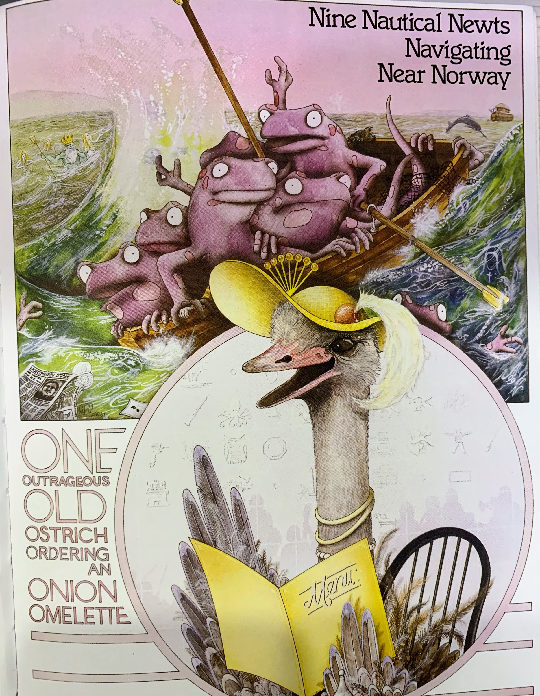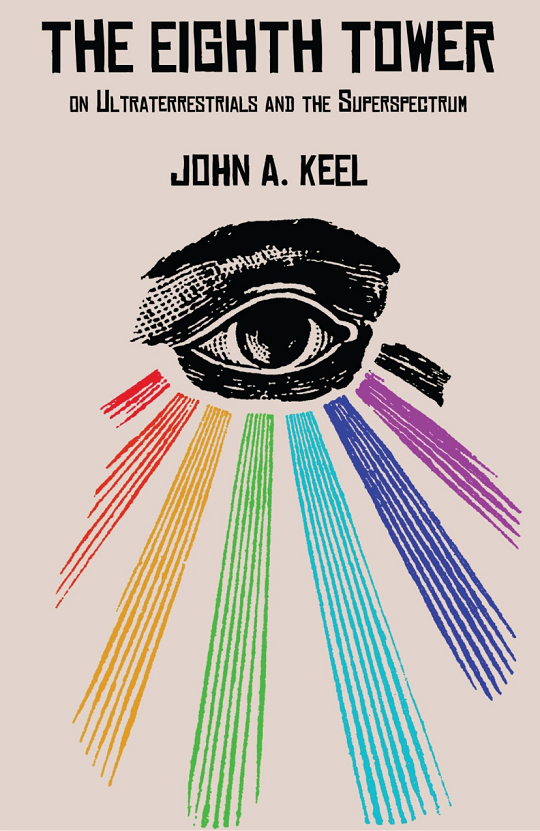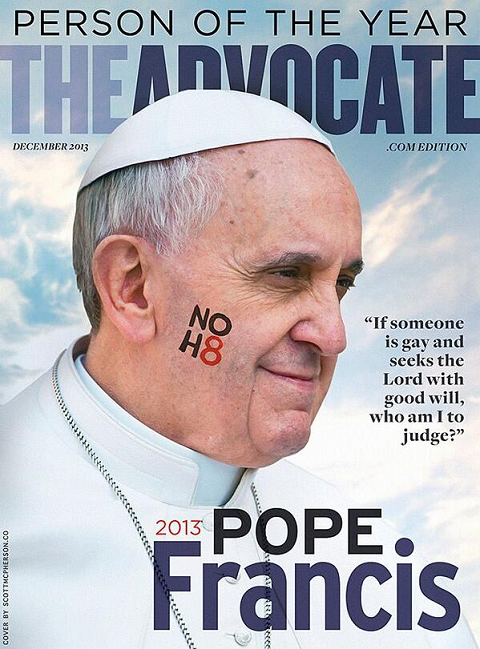At this rate I'm going to go through the whole freaking alphabet.
A newt is a kind of salamander. Although the picture is captioned "Nine Nautical Newts Navigating Near Norway," there are only six newts in the boat. The remaining three are in the water and are only partially visible. This immediately made me think of the Knight of Wands, recently discussed in "
More on Joan and Claire." The Knight's outer garment is printed with salamanders -- six full salamanders plus a few partially visible ones.

The newts are navigating the open sea, while the Knight and his salamanders are traveling through the deserts of Egypt. That's a pretty big discrepancy, but as it happens, I just mentioned in a comment on "
The horrible hairy homeward-hurrying hogs of Hieronymus" that "Egypt was also underwater when it was discovered" according to the Book of Abraham. This was following a train of thought started by the fact that the Hog Knight on the cover of
Animalia is accompanied by an ostrich, which had made me think of a passage from
The Satanic Verses related to the Norman Conquest. The Nautical Newts are also accompanied by an ostrich.
Actually, the Hog Knight has a lot in common with the Knight of Wands:
Both are wearing armor and riding in the same direction. The helmet of the Knight of Wands even appears to have one of those hounskull-style visors which, when closed, would give the Knight a "pig-faced" appearance. The Hog Knight holds a flagpole with a banner; the Knight of Wands holds a staff which, in my post, I connected with a flagpole as well. The Knight of Wands is in Egypt; the Hog Knight's banner, as seen inside the book, is decorated with what appear to be Egyptian hieroglyphics:
In the comment, I quote the statement that the discoverer of this underwater Egypt was "the daughter of Ham" and that she "afterward settled her sons in it," and I suggest that "hogs could be a punning reference to 'Ham.'" That Ham pun in its classic form, the one famously referenced by Bloom in Ulysses, includes a desert reference:
Why should no man starve on the deserts of Arabia?
Because of the sand which is there.
How came the sandwiches there?
The tribe of Ham was bred there and mustered.
Ham, bread, and mustard -- a very respectable pun. "Mustering" is something that military men do, which fits with the warlike portrayal of the tribe of ham in Animalia. Mustard is also interesting in connection with the Nautical Newts. It is the scholarly consensus that "eye of newt," the famous witches'-brew ingredient, originally referred to mustard seed. The Synoptic Gospels have Jesus compare the Kingdom to a grain of mustard seed, and Joseph Smith adapted the parable to apply to the Book of Mormon:
Let us take the Book of Mormon, which a man took and hid in his field, securing it by his faith, to spring up in the last days, or in due time; let us behold it coming forth out of the ground, which is indeed accounted the least of all seeds, but behold it branching forth, yea, even towering, with lofty branches, and God-like majesty, until it, like the mustard seed, becomes the greatest of all herbs. And it is truth, and it has sprouted and come forth out of the earth, and righteousness begins to look down from heaven, and God is sending down His powers, gifts and angels, to lodge in the branches thereof.
The mustard seed is planted and grows in a field, but the mustard seed is also mentioned in Luke in connection with the idea that a tree could be planted in the sea by those with sufficient faith:
And the Lord said, If ye had faith as a grain of mustard seed, ye might say unto this sycamine tree, Be thou plucked up by the root, and be thou planted in the sea; and it should obey you (Luke 17:6).
Joseph Smith connected the mustard seed with a book of scripture buried in the earth. The Nautical Newts appear to have their own seaborne scripture -- a Nautical New T., or New Testament. Keeping in mind that the word translated as gospel in the Bible literally means "good news," the symbolism is pretty clear:
The name of the newspaper is The Northern Star, which makes me think that this "gospel" is the writings of the Lost Tribes, as mentioned in 2 Nephi 29, since those tribes are traditionally thought of as being "in the North." We typically speak of the Ten Lost Tribes, but they could also be reckoned as nine, if (as is often the case in the Bible) Joseph is counted as a single tribe rather than being divided into the half-tribes of Ephraim and Manasseh. The Book of Mormon never gives them a number, though we know that there were 12 tribes in all and that three (Judah, Benjamin, and Levi) were not "lost."
Touching the newspaper is a snail shell. Well, I suppose it's actually a
nautilus shell, given the alphabet theme, but it certainly looks like a snail shell. In "
The Gospel of Luke on lobsterback," I specifically brought in snails as a symbol of a Gospel being transported across the sea. The snail in that analysis (from Lewis Carroll) was paired with the whiting, and here the snail shell is white. In Carroll, the idea of whiting having their tails in their mouths is emphasized; we see the same pose in the salamanders on the Knight of Wands.
To the right of the snail shell, we can see the ghostly image of what I suppose is meant to be a nurse, but her hat -- a rectangular shape marked with a cross -- is symbolic shorthand for "Bible," confirming our interpretation of the newspaper.
The Newts are navigating "Near Norway." Norway is, etymologically, "the northern way," which fits in with the Lost Tribes theme. The Old English name for Norway was Norðmanna land -- "Northman Land" -- which is also the etymological meaning of Normandy. Since Armorica (comprising Normandy and Brittany) has been so prominent in the sync-stream of late, we could think of "Near Norway" as referring to the Northman Land nearer to Britain -- i.e., Normandy as opposed to Norway in Scandinavia.
Finally, coming back to Ham for a moment, note that he is also implicitly present in the Nautical Newts picture, as one of the eight passengers on Noah's Ark:
By the way, I wasn't kidding about going through almost the whole alphabet. Stay tuned next time for the esoteric significance of Zany Zebras Zigzagging in Zinc Zeppelins.

























